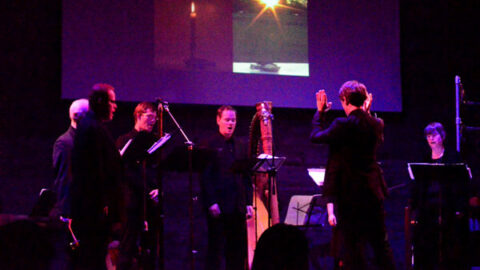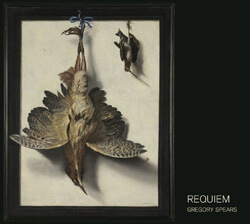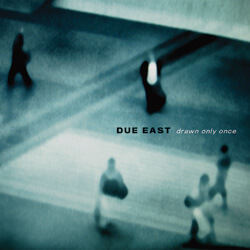 It was a big night yesterday for New Amsterdam Records. The New York based label was having a double release party at the sumptuous Dumbo venue: Gregory Spears‘s Requiem, and drawn only once, music by John Supko performed by Due East.
It was a big night yesterday for New Amsterdam Records. The New York based label was having a double release party at the sumptuous Dumbo venue: Gregory Spears‘s Requiem, and drawn only once, music by John Supko performed by Due East.
Scored for six voices (4 male, 2 female), harp, troubadour harp, recorders, baroque viola, chimes, and electric organ, Requiem draws from a variety of influences, from American and Danish (?) minimalism to baroque, and renaissance vocal music. It was incidentally receiving its concert premiere since the first performance in June of 2010 was part of an opera/dance collaboration with choreographer Christopher Williams for Williams’ dance production Hen’s Teeth.
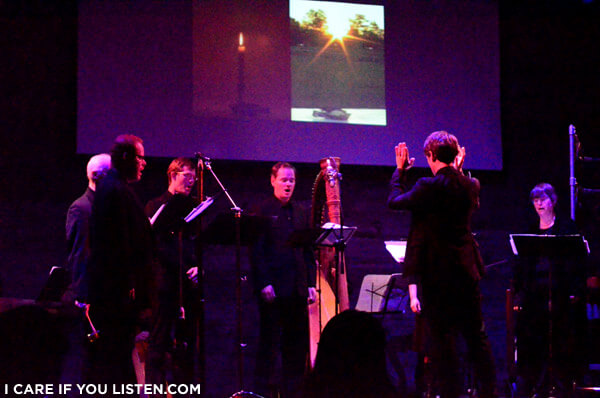
The piece opened with tensed harmonies on the harp accompanied by distant female voices and drone notes held by the male choir. And then the magic started. What a pleasure to hear beautifully crafted vocal lines, inspired by renaissance polyphony but still infusing a contemporary affect. The unselfconscious beauty of Spears’s music is rarely heard in contemporary music. The harp part alone was well worth the trip to Dumbo and it made me fantasize about what Fauré could have written if he had listened to Björk’s Vespertine. I thoroughly enjoyed Spears’s writing for voices, his clever use of phonemes on the Agnus Dei, and his 21st century spin on prosody.
Loosely based on a Requiem structure, Spears also borrows from popular tales of Brittany and a text by Baïf (a foremost figure in French Renaissance literature, poet, member of La Pléiade, and originator of the French vers mesurés…) to craft a real personal narrative mirrored by a video of a time-lapse projected behind the performers. I must admit that I was so taken by the music that I really paid very little attention to the slow-paced video… The instrumentation was very effective, but the baroque viola was often lost in the mix, along with the organ and the lower range of the pedal harp. An issue that one won’t have on the recording of course.
One could tell that the performers had a solid background in Renaissance/Baroque music but displayed, nonetheless, a gentle ease in their singing/playing.
The second half of the evening featured John Supko’s piece for flute, electronics and percussions, Littoral. The piece was accompanied by a video by Kristine Marx, and some texts by contemporary Dutch writer Cees Nooteboom and 16th Century English writer Richard Hakluyt.
Erin Lesser and Greg Beyer are Due East, the ensemble that was performing Littoral last night. Beyer, stage left, was surrounded by an impressive set of percussions: marimba, vibes, glockenspiel, gongs, etc. while Lesser, stage right, was standing with her three flutes by her side. Marx’s video was the central element on stage and it started with a series of blurred sequences where one could recognize the sea, some landscape, overlaid with geometric shapes and lines. The music was equally evasive and restricted to a few pitches. Soon after a pulse settled and was to remain steady for pretty much the entirety of the piece…
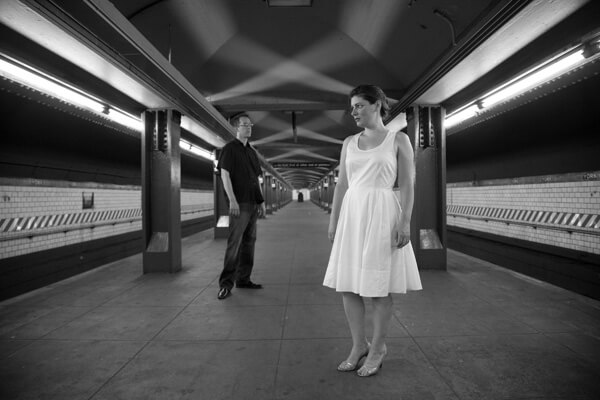
The pace of the video also picked up and was accompanied by an intense musical activity showcasing the virtuosity of Due East. Urban scenes replaced solarized images of a shore as a syncopated stream of notes moved chromatically towards an apex. After a brief moment of relief, beautiful visions of the ocean were displayed (in color for the first time), along with old maps and meridians as Lesser seemed to emulate seagulls with her piccolo. The passage was enhanced by sea sounds in the electronics and Lesser switched to an alto flute for the most lyrical passage of the piece. This was not where it was supposed to end, though, and the musical activity resumed along with the reciting suggesting an arch form. Finally the uncertainty of the beginning was recalled in the last minutes of the piece as blurred pictures appeared again on the screen.
The impression that this piece left me was quite different from the one inspired by Spears’s Requiem. Flirting at times with what felt like neurosis, with strong visual stimuli (the most active sequences of Marx’s video were quasi stroboscopic given the lowly lit environment of Galapagos and I found myself looking away from the screen a couple of times). The “hike” was strenuous to reach the beautiful vista offered by Lesser on the alto flute. The walk downhill was not a pleasant one. Nevertheless, I would really love to see Due East perform again and I will make sure to keep an eye on their website…
Regardless of what one could think of the pieces, this evening was definitely a success for New Amsterdam Records. Yesterday night’s program was in line with their desire to support “adventurous new music with an open embrace of the latest technological and cultural trends.” With a dream roster of artists, and a laid back approach to avant garde music, New Amsterdam Records is one of the strongest assets of New York’s new music scene.
Epilogue?
Both pieces could have been labeled multimedia (the second more so than the first) and as I see more of these (some extremely good) I am left wondering if that is really where performances should go. Ten years ago such installations had the potential to be refreshing and fascinating. What is now the value of a multimedia work in a world where we are surrounded with images on screens—in our pockets, on the train, on the street, in elevators, in planes, etc. I would tend to think that audiences would be more engaged by dramatic, low tech, DIY, non-multimedia pieces since a vast majority spend their day sitting in front of a computer.
What do you think? Leave a comment or tweet at us @icareifulisten
